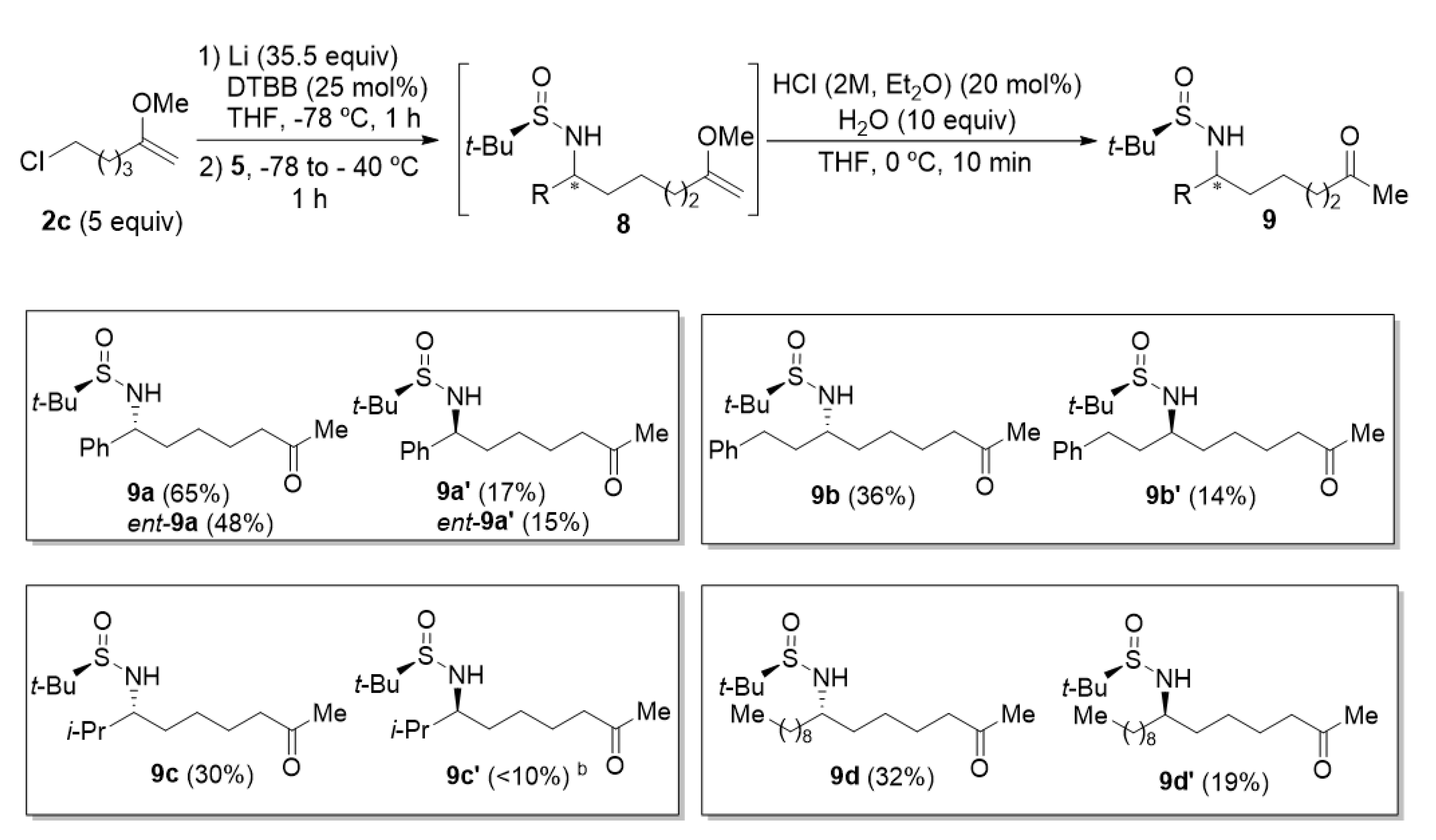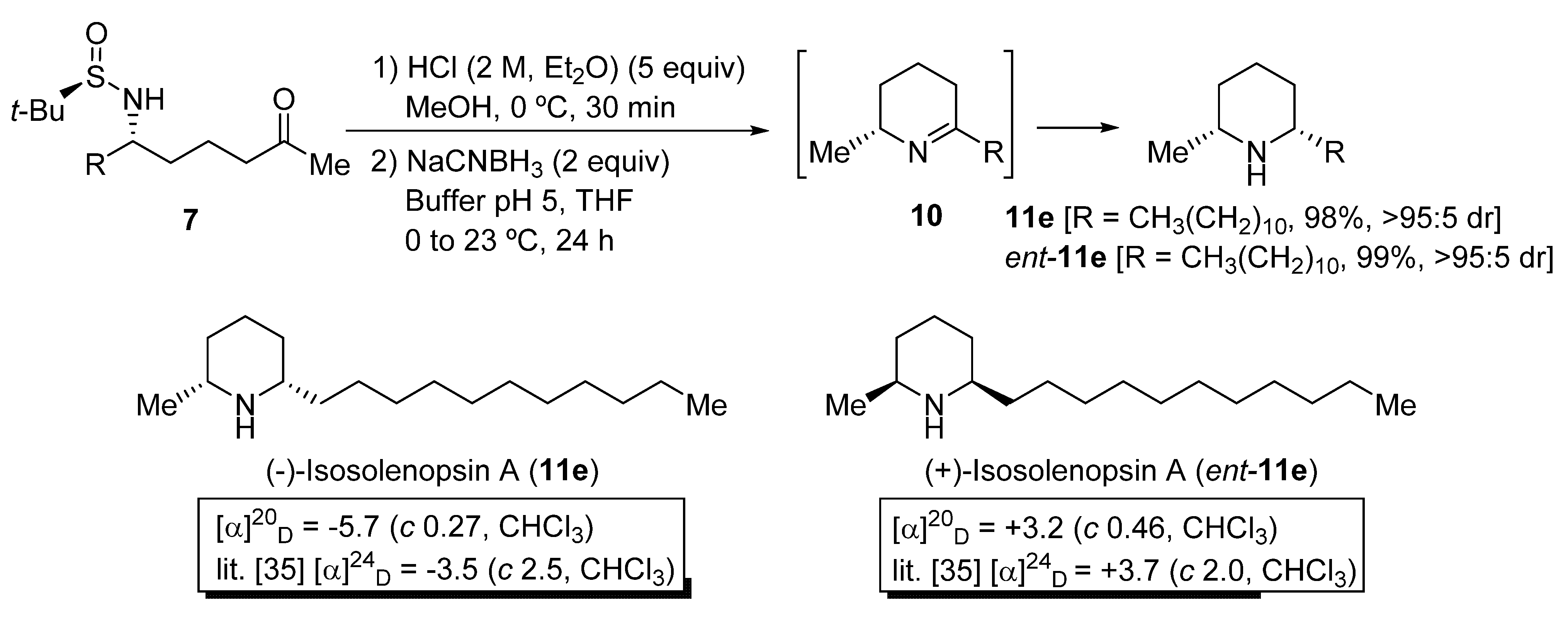Stereoselective Synthesis of δ- and ε-Amino Ketone Derivatives from N-tert-Butanesulfinyl Aldimines and Functionalized Organolithium Compounds †
Abstract
1. Introduction
2. Results and Discussion
2.1. Synthesis of 2-Methoxy-1-alkenyl Chlorides 2
2.2. Synthesis of N-tert-Butanesulfinyl δ-Amino Ketone Derivatives 7
2.3. Synthesis of N-tert-Butanesulfinyl ε-Amino Ketone Derivatives 9
2.4. Synthesis of Piperidines 11 and Azepanes 13 from N-tert-Butanesulfinyl Amino Ketone Derivatives 7 and 9
3. Materials and Methods
3.1. General Information
3.2. Preparation and Characterization of Compounds
3.2.1. Synthesis of 2-Methoxy-1-alkenyl Chlorides 2
3.2.2. Synthesis of N-tert-Butanesulfinyl Amino Ketone Derivatives 7 and 9
3.2.3. Synthesis of Piperidines 11 and Azepanes 13 from N-tert-Butanesulfinyl Amino Ketone Derivatives 7 and 9
4. Conclusions
Supplementary Materials
Author Contributions
Funding
Data Availability Statement
Conflicts of Interest
Sample Availability
References
- Baktharaman, S.; Hili, R.; Yudin, A.K. Amino carbonyl compounds in organic synthesis. Aldrichim. Acta 2008, 41, 109–119. [Google Scholar]
- Allen, L.A.T.; Raclea, R.-C.; Natho, P.; Parsons, P.J. Recent advances in the synthesis of α-amino ketones. Org. Biomol. Chem. 2021, 19, 498–513. [Google Scholar] [CrossRef]
- Alvim, H.G.O.; da Silva, E.N., Jr.; Neto, B.A.D. What do we know about multicomponent reactions? Mechanisms and trends for the Biginelli, Hantzsch, Mannich, Passerini and Ugi MCRs. RSC Adv. 2014, 4, 54282–54299. [Google Scholar] [CrossRef]
- Zhang, W.; Wang, X.; Zhu, B.; Zhu, D.; Han, J.; Wzorek, A.; Sato, A.; Soloshonok, V.A.; Zhou, J.; Pan, Y. Diastereoselective regiodivergent Mannich versus tandem Mannich-cyclization reactions. Adv. Synth. Catal. 2017, 359, 4267–4273. [Google Scholar] [CrossRef]
- Khandare, S.P.; Reddy, P.O.; Prasad, K.R. Addition of lithium anion of (acetylmethylene)triphenylphosphorane to nonracemic sulfinimines: Total synthesis of (+)-241D and formal total synthesis of (+)-preussin. Org. Lett. 2020, 22, 7273–7277. [Google Scholar] [CrossRef]
- Mazzeo, G.; Longhi, G.; Abbate, S.; Mangiavacchi, F.; Santi, C.; Han, J.; Soloshonok, V.A.; Melensi, L.; Ruzziconi, R. Mannich-type addition of 1,3-dicarbonyl compounds to chiral tert-butanesulfinyltrifluoro-acetaldimines. Mechanistic aspects and chiroptical studies. Org. Biomol. Chem. 2018, 16, 8742–8750. [Google Scholar] [CrossRef]
- Li, W.; Wang, Y.; Xu, D. Asymmetric synthesis of β-amino ketones by using cinchona alkaloid-based chiral phase transfer catalysts. Org. Biomol. Chem. 2018, 16, 8704–8709. [Google Scholar] [CrossRef]
- Allais, C.; Grassot, J.-M.; Rodriguez, J.; Constantieux, T. Metal-free multicomponent syntheses of pyridines. Chem. Rev. 2014, 114, 10829–10868. [Google Scholar] [CrossRef] [PubMed]
- Cayuelas, A.; Serrano, L.; Najera, C.; Sansano, J.M. Synthesis of α,β-diamino acid derivatives via asymmetric Mannich reactions of glycine imino esters catalyzed by a chiral phosphoramidite·silver complex. Tetrahedron Asymmetry 2014, 25, 1647–1653. [Google Scholar] [CrossRef]
- Ishitani, H.; Suzuki, H.; Saito, Y.; Yamashita, Y.; Kobayashi, S. Hafnium trifluoromethanesulfonate [Hf(OTf)4] as a unique Lewis acid in organic synthesis. Eur. J. Org. Chem. 2015, 5485–5499. [Google Scholar] [CrossRef]
- Decostanzi, M.; Campagne, J.-M.; Leclerc, E. Fluorinated enol ethers: Their synthesis and reactivity. Org. Biomol. Chem. 2015, 13, 7351–7380. [Google Scholar] [CrossRef]
- Ji, X.; Huang, H. Synthetic methods for 1,3-diamines. Org. Biomol. Chem. 2016, 14, 10557–10566. [Google Scholar] [CrossRef]
- Vargas-Caporali, J.; Juaristi, E. The diamino analogues of privileged Corey–Bakshi–Shibata and Jørgensen–Hayashi catalysts: A comparison of their performance. Synthesis 2016, 48, 3890–3906. [Google Scholar] [CrossRef]
- Lin, G.-Q.; Xu, M.-H.; Zhong, Y.-W.; Sun, X.-W. An advance on exploring N-tert-butanesulfinyl imines in asymmetric synthesis of chiral amines. Acc. Chem. Res. 2008, 41, 831–840. [Google Scholar] [CrossRef]
- Ferreira, F.; Botuha, C.; Chemla, F.; Pérez-Luna, A. tert-Butanesulfinimines: Structure, synthesis and synthetic applications. Chem. Soc. Rev. 2009, 38, 1162–1186. [Google Scholar] [CrossRef]
- Robak, M.A.T.; Herbage, M.A.; Ellman, J.A. Synthesis and applications of tert-butanesulfinamide. Chem. Rev. 2010, 110, 3600–3740. [Google Scholar] [CrossRef] [PubMed]
- García-Muñoz, M.J.; Dema, H.K.; Foubelo, F.; Yus, M. Base-promoted diastereoselective addition of nitromethane and nitroethane to N-tert-butylsulfinyl imines: Synthesis of N-protected α-amino acids and amino ketones. Tetrahedron Asymmetry 2014, 25, 362–372. [Google Scholar] [CrossRef]
- González-Gómez, J.C.; Foubelo, F.; Yus, M. Tandem enantioselective conjugate addition-Mannich reactions: Efficient multicomponent assembly of dialkylzincs, cyclic enones and chiral N-sulfinimines. Tetrahedron Lett. 2008, 49, 2343–2347. [Google Scholar] [CrossRef]
- González-Gómez, J.C.; Foubelo, F.; Yus, M. Stereocontrolled synthesis of 1,3-amino alcohols by reduction of substituted 2-1-[tert-butylsulfinyl)amino]alkylcyclohexanones. Synthesis 2009, 12, 2083–2088. [Google Scholar] [CrossRef]
- González-Gómez, J.C.; Foubelo, F.; Yus, M. Modular stereocontrolled assembly of R2Zn, cyclic enones and N-tert-butylsulfinyl imines. J. Org. Chem. 2009, 74, 2547–2553. [Google Scholar] [CrossRef]
- Lahosa, A.; Soler, T.; Arrieta, A.; Cossio, F.P.; Foubelo, F.; Yus, M. Stereoselective coupling of N-tert-butanesulfinyl aldimines and β-keto acids: Access to β-amino ketones. J. Org. Chem. 2017, 82, 7481–7491. [Google Scholar] [CrossRef] [PubMed]
- Lahosa, A.; Yus, M.; Foubelo, F. Enantiodivergent approach to the synthesis of cis-2,6-disubstituted piperidin-4-ones. J. Org. Chem. 2019, 84, 7331–7341. [Google Scholar] [CrossRef] [PubMed]
- Nájera, C.; Yus, M. Functionalized organolithium compounds: New synthetic adventures. Curr. Org. Chem. 2003, 7, 867–926. [Google Scholar] [CrossRef]
- Chinchilla, R.; Nájera, C.; Yus, M. Metalated heterocycles and their applications in synthetic organic chemistry. Chem. Rev. 2004, 104, 2667–2722. [Google Scholar] [CrossRef] [PubMed]
- Foubelo, F.; Abou, A.; Yus, M. Chemoselective lithiation of 1-bromo-n-chloroalkanes. Eur. J. Org. Chem. 2005, 5089–5093. [Google Scholar] [CrossRef]
- Hudrlik, P.F.; Hudrlik, A.M. Enol acetates, enol ethers, and amines by mercuration of acetylenes. J. Org. Chem. 1973, 38, 4254–4258. [Google Scholar] [CrossRef]
- Plobeck, N.; Powell, D. Asymmetric synthesis of diarylmethylamines by diastereoselective addition of organometallic reagents to chiral N-tert-butanesulfinimines: Switchover of diastereofacial selectivity. Tetrahedron Asymmetry 2002, 13, 303–310. [Google Scholar] [CrossRef]
- García, D.; Moreno, B.; Soler, T.; Foubelo, F.; Yus, M. Stereoselective synthesis of 3-substituted tetrahydroisoquinolines from phthalan and chiral N-sulfinylimines. Tetrahedron Lett. 2009, 50, 4710–4713. [Google Scholar] [CrossRef]
- García, D.; Foubelo, F.; Yus, M. Reductive ring-opening of phthalan and isochroman: Application to the stereoselective synthesis of tetrahydroisoquinolines and tetrahydrobenzazepines. Eur. J. Org. Chem. 2010, 2893–2903. [Google Scholar] [CrossRef]
- Sassian, M.; Panov, D.; Tuulmets, A. Grignard reagents in toluene solutions. Appl. Organomet. Chem. 2002, 16, 525–529. [Google Scholar] [CrossRef]
- González-Gómez, J.C.; Foubelo, F.; Yus, M. Cross-metathesis of chiral N-tert-butylsulfinyl homoallylamines: Application to the enantioselective synthesis of naturally occurring 2,6-cis-disubstituted piperidines. Synlett 2008, 18, 2777–2780. [Google Scholar] [CrossRef]
- Medjahdi, M.; González-Gómez, J.C.; Foubelo, F.; Yus, M. Enantioselective synthesis of cis- and trans-2-methyl-6-nonylpiperidines: Alkaloids solenopsin and isosolenopsin. Heterocycles 2012, 86, 727–734. [Google Scholar]
- Bandara Herath, H.M.T.; Dhammika Nanayakkara, N.P. Synthesis of enantiomerically pure fire ant venom alkaloids: Solenopsins and isosolenopsins A, B and C. J. Heterocycl. Chem. 2008, 45, 129–136. [Google Scholar] [CrossRef]
- Jones, T.H.; Blum, M.S.; Fales, H.M. Ant venom alkaloids from Solenopsis and Monorium species. Tetrahedron 1982, 38, 1949–1958. [Google Scholar] [CrossRef]
- Leclercq, S.; Thirionet, I.; Broeders, F.; Daloze, D.; Vander Meer, R.; Braekman, J.C. Absolute configuration of the solenopsins, venom alkaloids of the fire ants. Tetrahedron 1994, 50, 8465–8478. [Google Scholar] [CrossRef]
- Liu, G.; Cogan, D.A.; Owens, T.D.; Tang, T.P.; Ellman, J.A. Synthesis of enantiomerically pure N-tert-butanesulfinyl imines (tert-butanesulfinimines) by the direct condensation of tert-butanesulfinamide with aldehydes and ketones. J. Org. Chem. 1999, 64, 1278–1284. [Google Scholar] [CrossRef]
- Schenkel, L.B.; Ellman, J.A. Self-condensation of N-tert-butanesulfinyl aldimines: Application to the rapid asymmetric synthesis of biologically important amine-containing compounds. Org. Lett. 2004, 6, 3621–3624. [Google Scholar] [CrossRef] [PubMed]
- Bertrand, M.B.; Wolfe, J.P. A concise stereoselective synthesis of preussin, 3-epi-preussin, and analogues. Org. Lett. 2006, 8, 2353–2356. [Google Scholar] [CrossRef] [PubMed][Green Version]
- Fontenelle, C.Q.; Conroy, M.; Light, M.; Poisson, T.; Pannecoucke, X.; Linclau, B. Stereoselectivity of the Honda–Reformatsky reaction in reactions with ethyl bromodifluoroacetate with α-oxygenated sulfinylimines. J. Org. Chem. 2014, 79, 4186–4195. [Google Scholar] [CrossRef] [PubMed]








| Entry | Reaction Conditions | Diastereomeric Ratio a | |
|---|---|---|---|
| 7a | 7a′ | ||
| 1 b | (1) THF, −78 to 23 °C, 15 h; (2) H2O | 44 | 56 |
| 2 b | (1) Et2O, −78 to 23 °C, 15 h; (2) H2O | 68 | 32 |
| 3 b | (1) PhMe, −78 to 23 °C, 15 h; (2) H2O | 70 | 30 |
| 4 c | (1) THF, −78 to −40 °C, 1 h; (2) H2O | 78 | 22 |
| 5 c,d | (1) Et2O, −78 to −40 °C, 1 h; (2) H2O | 75 | 25 |
Publisher’s Note: MDPI stays neutral with regard to jurisdictional claims in published maps and institutional affiliations. |
© 2021 by the authors. Licensee MDPI, Basel, Switzerland. This article is an open access article distributed under the terms and conditions of the Creative Commons Attribution (CC BY) license (https://creativecommons.org/licenses/by/4.0/).
Share and Cite
Sirvent, A.; Foubelo, F.; Yus, M. Stereoselective Synthesis of δ- and ε-Amino Ketone Derivatives from N-tert-Butanesulfinyl Aldimines and Functionalized Organolithium Compounds. Molecules 2021, 26, 6503. https://doi.org/10.3390/molecules26216503
Sirvent A, Foubelo F, Yus M. Stereoselective Synthesis of δ- and ε-Amino Ketone Derivatives from N-tert-Butanesulfinyl Aldimines and Functionalized Organolithium Compounds. Molecules. 2021; 26(21):6503. https://doi.org/10.3390/molecules26216503
Chicago/Turabian StyleSirvent, Ana, Francisco Foubelo, and Miguel Yus. 2021. "Stereoselective Synthesis of δ- and ε-Amino Ketone Derivatives from N-tert-Butanesulfinyl Aldimines and Functionalized Organolithium Compounds" Molecules 26, no. 21: 6503. https://doi.org/10.3390/molecules26216503
APA StyleSirvent, A., Foubelo, F., & Yus, M. (2021). Stereoselective Synthesis of δ- and ε-Amino Ketone Derivatives from N-tert-Butanesulfinyl Aldimines and Functionalized Organolithium Compounds. Molecules, 26(21), 6503. https://doi.org/10.3390/molecules26216503






